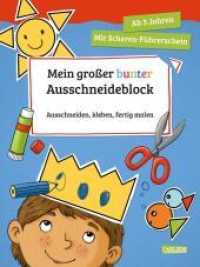- ホーム
- > 洋書
- > 英文書
- > History / World
Full Description
A fundamental component of the study of worked osseous objects is the identification of the raw materials chosen to make them. In archaeological contexts many objects become degraded to the point where identification is very difficult and the way in which these materials decay during burial and upon excavation can vary greatly. Correct identification is crucial to the investigation of objects, their conservation and future curation. Above all, understanding raw material selection aids our understanding of human-animal interaction in the past both on pragmatic and symbolic levels since the choices made by artisans vary by cultural tradition as well as availability.
The 20 papers presented here explore a wealth of information pertaining to the use of osseous materials over the long period of human craftsmanship and tool manufacture by exploring several key themes:
· Raw material selection and curation within tool types
· Social aspects of raw material selection
· New methods of materials identification
It is demonstrated that the issue of raw material identification has numerous implications for conservation work, reproduction of objects, the physical characteristics of the tool or ornament, availability of raw materials, the materials chosen for procurement and the cultural reasons that lie behind the choice of raw materials from particular species and skeletal elements to produce planned tool and ornament types. Together, these papers emphasize the need for confident and correct materials identification and demonstrate that functionality is by no means the only, nor necessarily the most important, factor in the selection of osseous raw materials for the fabrication of tools and other cultural objects
Contents
Preface Jean-Denis Vigne, Christine Lefèvre and Marylène Patou-Mathis
Introduction to the volume Alice Choyke and Sonia O'Connor
Keynote Paper
1. Hidden Agendas: Ancient Raw Material Choice for Worked Osseous Objects in Central Europe and Beyond
Alice Choyke
Raw Material Selection and Curation within Tool Types
2. Osseous Retouchers from the Final Mousterian and Uluzzian Levels at the Fumane Cave (Verona, Italy): Preliminary Results Camille Jéquier, Matteo Romandini, Marco Peresani
3. Raw Material Used in the Manufacture of Osseous Artefacts during the Upper Palaeolithic in Portugal Marina Almeida Évora
4. The Identification of Perishable Technologies through Usewear on Osseous Tools: Wear Patterns on Historic and Contemporary Tools as a Standard for Identifying Raw Materials Worked in the Late Upper Palaeolithic Elisabeth A. Stone
5. Bone Material and Design Choices in Southern Patagonia Vivian Scheinsohn
6. Changed into Tools. Camelid Bones from the Southern Calchaquí Valleys (Formative Period, Northwestern Argentina) Andrés D. Izeta, Roxana Cattáneo, M. Cristina Scattolin and Leticia I. Cortés
7. Osseous Raw Materials in Vinča culture Selena Vitezović
8. Seals, Seal Hunting and Worked Seal Bones in Estonian Coastal Region in the Neolithic and Bronze Age Heidi Luik
9. Specialization or Re-utilization? Study of the Selection Documented in a Bone-Working Refuse Assemblage from Roman Baetulo (Badalona, Spain) Lídia Colominas
Social Aspects of Raw Material Selection
10. The Materiality of Production: Exploring Variability and Choice in the Production of Palaeolithic Portable Art made in Antler and Bone Rebecca Farbstein
11. Evidence of Bone Technology on the Santa Fe's Pampa Lagoons. The Laguna El Doce Site (Santa Fe Province, Argentina) Jimena Cornaglia Fernández and Natacha Buc
12. Beyond Stones: Bone as Raw Material for Tools in the Central Plateau of Santa Cruz, Argentinean Patagonia Laura Miotti and Laura Marchionni
13. The Meaning of "Smoothing" Implements from the Levantine PPNB seen from the Basta Perspective Cornelia Becker
14. Tubular Bone Artefacts in Burial Context at Ajvide, Gotland c 2500 cal BC. Are they Musical Instruments? Kristiina Manermaa and Riitta Rainio
15. Strict Rules - Loose Rules: Raw Material Preferences at the Late Neolithic Site of Aszód, Central Hungary Zsuzsanna Tóth
16. More than Fun and Games? An Experimental Study of Worked Bone Astragali from Two Middle Bronze Age Hungarian Sites Jacqueline Meier
17. Economic and Social Context of Bone Tools Use, Formative Bolivia Katherine Moore
New Methods of Materials Identification
18. Exotic Materials Used in the Construction of Iron Age Sword Handles from South Cave, UK. Sonia O'Connor
19. An Introduction to ZooMS (Zooarchaeology by Mass Spectromtry) for Taxonomic Identification of Worked and Raw Materials Oliver W. Hounslow, Joanna P. Simpson, Lauren Whalley, Matthew J. Collins
20. Some Comments on the Identification of Cervid Species in Worked Antler Steven Ashby







